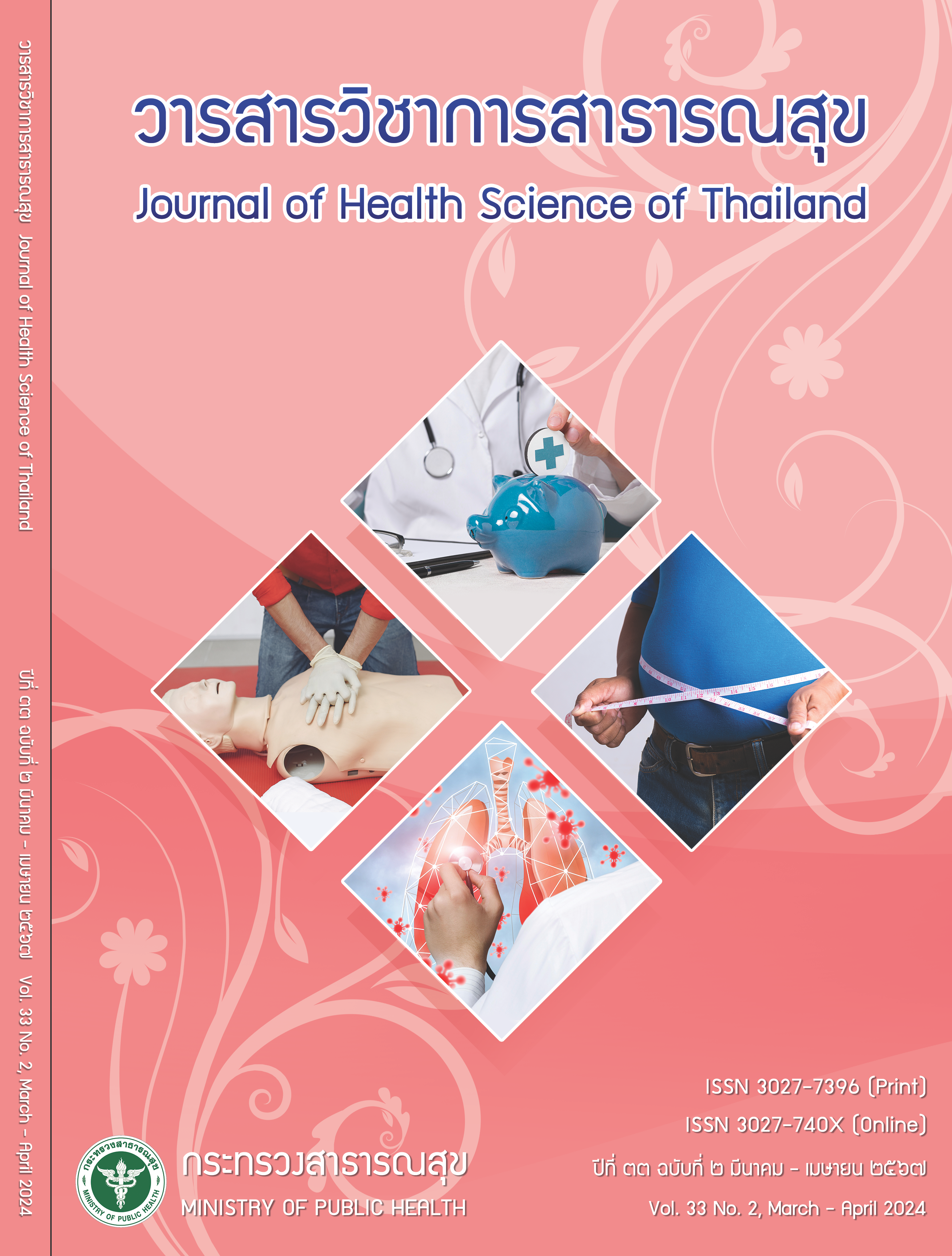ความชุกและสัญญาณความเสี่ยงของเหตุการณ์ไม่พึงประสงค์ของยาที่ได้รับจากแหล่งกระจายยาไม่เหมาะสมในชุมชน โดยวิเคราะห์จากฐานข้อมูลรายงานเหตุการณ์ไม่พึงประสงค์ของผลิตภัณฑ์สุขภาพ ประเทศไทย
คำสำคัญ:
การซื้อยารักษาตนเอง, เหตุการณ์ไม่พึงประสงค์จากยา, การใช้ยาอย่างสมเหตุผลบทคัดย่อ
การซื้อยารักษาตนเอง จากแหล่งกระจายยาไม่เหมาะสมในชุมชน ส่งผลให้เกิดเหตุการณ์ไม่พึงประสงค์จากยา และการเข้ารับการรักษาในสถานพยาบาล การศึกษาทีผ่านมายังไม่มีการวิเคราะห์ขนาดปัญหาและขนาดความเสี ่ ่ยง ของเหตุการณ์ไม่พึงประสงค์จากแหล่งกระจายยาไม่เหมาะสมในชุมชนภาพรวมประเทศ การศึกษาเชิงพรรณนา แบบย้อนหลังนี้ เป็นการศึกษาความชุกและสัญญาณความเสี่ยงของเหตุการณ์ไม่พึงประสงค์ที่รุนแรงของยา จากแหล่งกระจายยาไม่เหมาะสมในชุมชนภาพรวมประเทศ โดยวิเคราะห์จากข้อมูลเหตุการณ์ไม่พึงประสงค์ จากการใช้ยาและผลิตภัณฑ์สุขภาพ (adverse events: AEs) ปี 2564 – 2565 จากฐานข้อมูลรายงานเหตุการณ์ ไม่พึงประสงค์ของผลิตภัณฑ์สุขภาพ ประเทศไทย (Thai Vigibase) ในกลุ่มยาเป้ าหมายที่กระทรวงสาธารณสุข เฝ้ าระวัง ได้แก่ กลุ่มยาต้านการอักเสบที่ไม่ใช่สเตียรอยด์ (NSAIDs) ยาสเตียรอยด์ (steroids) และยาปฏิชีวนะ (antibiotics) ใช้การวิเคราะห์ข้อมูลด้วยสถิติเชิงพรรณา ได้แก่ จำนวน และร้อยละ คำนวณค่า reporting odds ratio และช่วงความเชื่อมั่น เพื่อวิเคราะห์สัญญาณความเสี่ยง โดยใช้โปรแกรม STATA/IC version 14.0 พบว่า จำนวน AEs จากแหล่งกระจายยาไม่เหมาะสม ปี 2564 และ 2565 เท่ากับ 279 จากจำนวนเหตุการณ์ทั้งหมด 136,453 เหตุการณ์ และ 295 จากเหตุการณ์ทั้งหมด 99,642 เหตุการณ์ตามลำดับ ร้านชำเป็นแหล่งกระจาย ยาไม่เหมาะสม ที่ส่งผลต่อให้เกิด AEs มากที่สุด (ปี 2564 ร้อยละ 75.27 ปี 2565 ร้อยละ 72.88) กลุ่มยาที่ ทำให้เกิด AEs มากที่สุด 3 ลำดับแรก ได้แก่ anti-inflammatory and antirheumatic products, systemic antibiotics และ analgesics ตามลำดับ โดยชื่อยาที่พบ AEs มากที่สุดใน 3 ลำดับแรก คือ กลุ่มยา NSAIDs และ antibiotic ได้แก่ piroxicam, tetracycline, diclofenac ทั้งนี้ความชุกของเหตุการณ์ไม่พึงประสงค์ของยาจาก แหล่งกระจายยาไม่เหมาะสม ปี 2564 และปี 2565 มีค่าเท่ากับ 0.20 และ 0.30 ตามลำดับ ความชุกของกลุ่มยาเป้ าหมายที่เฝ้ าระวัง ได้แก่ NSAIDs, Antibiotic และ Steroid ในปี 2564 มีค่าเท่ากับ 0.009, 0.004 และ 0.003 ตามลำดับและ ปี 2565 มีค่าเท่ากับ 0.013, 0.004 และ 0.03 ตามลำดับ โดย NSAIDs เป็นกลุ่มยา เดียวที่พบสัญญาณความเสี่ยงต่อการเกิด AEs ที่รุนแรง ซึ่ง diclofenac เป็นยาชนิดเดียวที่พบสัญญาณเสี่ยง ใน ปี 2564 ผลการศึกษาดังกล่าว กระทรวงสาธารณสุข สามารถใช้เป็นข้อมูลพื้นฐานเพื่อติดตามผลตามแนวทาง การใช้ยาอย่างสมเหตุผลในชุมชนของกระทรวงสาธารณสุข และกำหนดมาตรการจัดการความเสี่ยง ทั้งส่วนกลาง และพื้นที่ ต่อกลุ่มยาที่มีสัญญาณความเสี่ยงจากการเกิด AEs รุนแรง รวมทั้งส่งเสริมให้ทุกโรงพยาบาลทุกสังกัด วางระบบเฝ้าระวังความปลอดภัยด้านยาเชิงรุกในโรงพยาบาล ตามแนวทางดังกล่าว ตลอดจนส่งเสริมให้โรงพยาบาล รายงานข้อมูลให้ครบถ้วน ถูกต้อง เพื่อให้มีข้อมูลคุณภาพสู่ Thai Vigibase เพื่อใช้เฝ้ าระวังอย่างต่อเนื่องต่อไป
Downloads
เอกสารอ้างอิง
Chungsathiensap K, Sri-ngernyuang L, Paonil W. Medicine and the community: social and cultural dimensions. 1st edition. Nonthaburi: Office of Social and Health Research; 2007.
Food and Drug Administration. Project to promote safe drug use in the community 2018-2020. Nonthaburi: Food and Drug Administration; 2020.
Strategy and Planning Division, Office of the Permanent Secretary, Ministry of Public Health. Indicators for the fiscal year 2023: Ministry of Public Health [Internet]. [cited 2023 Jul 5]. Available from: https://spd.moph. go.th/kpi-template-2566/
Ruksarantwara M. Prevalence and classification of adverse reactions from drug use, Soi Dao Hospital. Journal of the Center for Clinical Medicine Education Phrapokklao Hospital 2015;32(4):332-47.
Salamon P, Ruengorn C, Seangphichai S, Wonghankla B. Epidemic of inappropriate health products and associated adverse events among chronic disease patients in border area, Wieng Kan District, Chiang Rai Province. Thai Pharmaceutical Journal 2019;11(2);307-17.
Boonyong A, Muenpa R. Prevalence of inappropriate drug sales in tea shops in Phitsanulok Province and factors affecting it. Thai Pharmaceutical Journal 2018; 11(1);105-18.
Kaewkhambong C. Situation and management of the problem of distribution of antibiotics and “ya chud” in the community. Government Pharmaceutical Organization Journal 2019;45(4):38-44.
Kaewsutthi T, Phorruean N. Prevalence and factors associated with inappropriate drug exposure in the elderly. Journal of Mind–Body and the Vulnerable 2021;4(3): 69-80.
Saokaew S, Suwankesawong W, Permsuwan U, Chaiyakunapruk N. Safety of herbal products in Thailand: an analysis of reports in the Thai health product vigilance center database from 2000 to 2008. Drug Saf 2011; 34(4):339-50.
Suwankesawong W, Saokaew S, Permsuwan U, Chaiyakunapruk N. Characterization of hypersensitivity reactions reported among Andrographis paniculata users in Thailand using Health Product Vigilance Center (HPVC) database. BMC Complement Altern Med 2014;24(14): 515.
Pokakul P, Kulsomboon W. Signal detection of blood glucose lowering drugs and herbal medicines in the Thai databases on adverse drug events (Thai Vigibase). Thai Pharmacy Journal 2019;11(2):333-41.
Wechwithan S, Suwankesawong W, Sornsrivichai V, McNeil EB, Jiraphongsa C, Chongsuvivatwong V. Signal detection for Thai traditional medicine: examination of national pharmacovigilance data using reporting odds ratio and reported population attributable risk. Regul Toxicol Pharmacol 2014;70(1):407-12.
Prasitdumrong H, Duangmee K, Boonmuang P, Santimaleeworagun W, Oppamayun Y, Sonsupap C, et al. Incidence of urticaria, angioedema, and type I hypersensitivity reactions associated with fibrinolytic agents in Thailand using the database of the health product vigilance center. Asian Pac J Allergy Immunol 2023;41(1):67- 72.
Health Administration Division, Office of the Permanent Secretary, Ministry of Public Health. Report of the meeting of the working group to develop a system for rational and safe drug use in the community and related parties on 28 - 29 November 2022. Nonthaburi: Office of the Permanent Secretary, Ministry of Public Health; 2023.
van Puijenbroek EP, Bate A, Leufkens HG, Lindquist M, Orre R, Egberts AC. A comparison of measures of disproportionality for signal detection in spontaneous reporting systems for adverse drug reactions. Pharmacoepidemiol Drug Saf 2002;11(1):3-10.
US Food and Drug Administration. What is a serious adverse event? [Internet]. [cited 2023 Jul 5]. Available from: https://www.fda.gov/safety/reporting-serious-problems-fda/what-serious-adverse-event
Uppsala Monitoring Centre. Signal detection [Internet]. [cited 2023 Jul 5]. Available from: https://who-umc. org/signal-work/signal-detection/
Chautrakarn S, Khumros W, Phutrakool P. Self-medication with over-the-counter medicines among the working age population in metropolitan areas of Thailand. Front Pharmacol 2021;11(12):726643.
Boonyot S, Muenpa R. Situation of distribution and use of common household medicines in the community. A district in the northeastern region. Thai Pharmacy Journal 2020;13(3):578-89.
Berreni A, Montastruc F, Bondon-Guitton E, Rousseau V, Abadie D, Durrieu G, et al. Adverse drug reactions to self-medication: a study in a pharmacovigilance database. Fundam Clin Pharmacol 2015;29(5):517-20.
Rashid M, Chhabra M, Kashyap A, Undela K, Gudi SK. Prevalence and predictors of self-medication practices in India: a systematic literature review and meta-analysis. Curr Clin Pharmacol 2020;15(2):90-101.
ดาวน์โหลด
เผยแพร่แล้ว
วิธีการอ้างอิง
ฉบับ
บท
การอนุญาต
ลิขสิทธิ์ (c) 2024 กระทรวงสาธารณสุข

This work is licensed under a Creative Commons Attribution-NonCommercial-NoDerivatives 4.0 International License.







